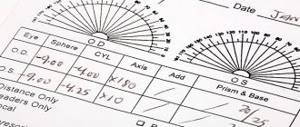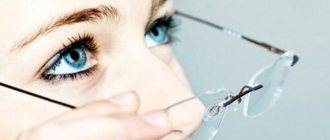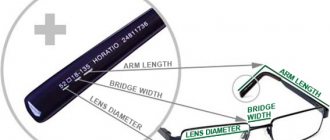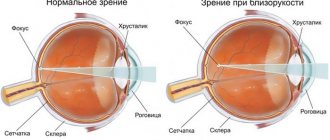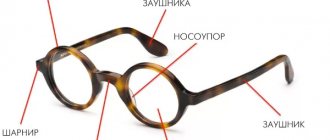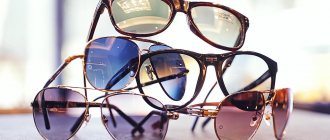If a person has concomitant vision pathologies, correction of age-related changes can become significantly more complicated. In this case, you will need several pairs of glasses. Some are for seeing well into the distance and, as a rule, they need to be worn constantly.
The latter are used only when reading, working on a computer, writing articles or viewing photographs. Of course, keeping two pairs of glasses with you is not very convenient and not always possible.
The invention of bifocal glasses solved this problem. These glasses are intended for people who, along with myopia, also have farsightedness, mainly older people.
Share
Tweet
Share
Cool
Send
Features of bifocal glasses
Bifocal glasses are an optical product that allows you to correct presbyopia in order to see objects at both close and far distances. Visually, these glasses have absolutely no differences from classic ones.
The lenses in these glasses are divided into two visible halves. The upper part is responsible for distance vision. The lower segment improves focusing at close distances.
When making bifocal glasses, special attention is paid to the lower eyepiece. Since it is precisely this that is the boundary of switching the gaze to examine objects at close range.
The main feature of such glasses is that they eliminate the need to have several pairs of glasses. But this type of optics also has several disadvantages, namely:
- Not everyone may like the look of lenses with a clear transition edge;
- lack of optical zone for medium distance.
Bifocals may cause fatigue after watching TV or reading for a long time.
Expert opinion
Nosova Yulia Vladimirovna
Ophthalmologist of the highest category. Candidate of Medical Sciences.
For people suffering only from myopia, the upper lenses are replaced with zero glasses without diopters. The lower part in this case may occupy half of the glass or its lower part. If we talk about the shape, then the person’s personal preference is important; it can be round or square.
In the modern world, such glasses are very popular due to the ability to quickly change focus, which is especially important for those who work with small objects.
Such glasses are especially relevant for older people, as well as people who use this type of optics in their activities: jewelers, watchmakers, writers and others.
The idea of creating such glasses belongs to Benjamin Franklin, who divided the lens into two parts and connected halves of different diopters together.
Types of multifocal optics
What is common in all types of presbyopia correction is that they are dominated by a pair of zones with different powers, which makes it possible to recognize close and distant elements.
On the modern market, multifocal lenses are shown in the following types:
- Bifocal – have two parts (the lower one helps to recognize near objects, the upper one – those located far away). They are mainly used to correct presbyopia. This optical device eliminates the need for a person to carry several pairs of glasses. However, bifocals also have some disadvantages: the separation line is very noticeable; With frequent bending and turning of the head, a feeling of eye fatigue appears and a headache may occur. There are 2 types of bifocal glasses:
- variables – the far vision area is located at the top, the near vision area is located at the bottom; there is a clear line in the middle; for a comfortable position on the eye there is a special cut below;
- concentric - the best option, here the zones are made in the form of rings, alternating; in the middle there may be a zone for distance or near (set individually for each).
- Progressive - in such accessories the lines between zones are completely invisible, one area smoothly transforms into another. Therefore, they look more elegant than the first type. Progressive glasses differ in the size of the zones, level of adaptation, cost, and customer needs. There are 3 types in total: individual, standard, individualized. The only disadvantages of lenses are the high cost, long adaptation, and the presence of “blind” spots.
- Trifocal - glasses provide excellent visibility at various distances, both far and near. Experts prescribe them to people with progressive presbyopia. They are also indicated for hypermetropia and high levels of myopia. The disadvantage of trifocal glasses is the visibility of outlines between zones and long-term adaptation.
An ophthalmologist can determine which type is right for the patient after conducting a preliminary examination.
Multifocal glasses
Both bifocal and other outdated models are giving way to new and modern products. Multifocal glasses are products that have not only zones of near and far vision, but also intermediate vision, which also plays an important function in the overall visual process.
Just like bifocals, multifocal glasses are equipped with two optical zones. In this case, there is no obvious transition between the lenses. Modern models with multifocal design are so high-tech that they themselves can adapt to the human brain.
Their peculiarity is that they themselves determine where the gaze is directed, thereby providing a clear image. The process happens so quickly that a person does not notice it.
Multifocal glasses can be used not only for presbyopia, but also for other types of refraction. They can be used if you have myopia. They are in greatest demand among young people because they have more beautiful frames that do not distort the shape of the eyes.
The market offers a huge selection of forms of multifocal glasses, which are selected depending on the visual acuity, age and profession of the patient. Lenses can be large or small, just as glasses can have different shapes.
A smooth transition between zones allows you to maintain stable eye sharpness for a long time. Since the load on the visual apparatus is minimal, this avoids eye fatigue.
Advantages and disadvantages
The main advantages include:
- Availability. Bifocals are a little more expensive than regular glasses.
- Now you don't need to have two pairs of glasses.
- Individual selection of sizes and settings for each client.
Despite the obvious advantages, this type of optics also has its disadvantages:
- Bifocals are not suitable for driving. Because the gaze should be directed straight, and they are bifocal. In this case, trifocal products with three lenses of different powers are suitable.
- Since the dividing strip may stand out strongly, it will create a visual defect.
- The difference between diopters should be no more than 5 to avoid additional strain on the eyes when constantly switching views between different glasses.
- Presence of blind spots.
- With prolonged use, it is possible that unpleasant symptoms such as nausea, dizziness or pain in the eye area may appear.
- A long period of habituation and adaptation is possible.
How to get used to glasses
Most people get used to multifocal products quite quickly and painlessly. However, if the feeling of discomfort is constant, you need to contact a specialist again to select other means of correction.
Initially, in the first days of use, you should develop a certain habit of lowering and raising your head in a timely manner. But you shouldn’t turn it sharply; you may get dizzy.
Before prescribing glasses, the doctor will perform a list of studies necessary to select the correct glasses. And if it is not possible to choose the appropriate type or the person feels discomfort, more modern methods of correction are used - contact lenses.
How can I get a prescription for these glasses?
If the question arises of purchasing dual optics, then in this case you will need several prescriptions from an ophthalmologist. The attending physician must evaluate visual acuity at different distances. The remaining prescription is issued after a series of manipulations, which include:
- Checking visual acuity using a special table. This method is called visometry.
- Refractometry is the most accurate research method that allows you to detect presbyopia, even at the earliest stages. It is carried out using a special device to determine the refractive abilities of the visual apparatus.
Types of glasses
Today on the market you can find many different types of multifocal products, characterized by design, material, performance technology, distribution, and level of consideration of individual characteristics.
According to distribution, special and universal glasses are distinguished. The first should be used when performing any exercises; they can be computer or office. The latter provide vision at different distances.
Based on technology and design, individual, optimized, and traditional lenses are distinguished. The first ones are considered the most effective; when they are performed, a person’s personal visual characteristics are determined.
Features of choice
First you need to determine the bending force of each eyepiece. As a rule, lenses without refractive features are most often sufficient, that is, a lens with a minus at the bottom and a zero at the top.
Such products are chosen by patients suffering from myopia, who have trouble seeing objects at close range, but can perfectly see objects at a far distance.
Lenses with a minus at the bottom and a plus at the top are used by patients with problems seeing objects at both near and far distances. As a rule, such glasses are prescribed to older people.
Sometimes the negative area may be located at the top. Such optical products are chosen by those who need to look at small objects located above eye level. The size ratio of the eyepieces directly depends on the frequency of use. If the glasses will be used mainly for reading, then the lower part of the lens will take up half the surface.
The lenses themselves can be of various shapes, from round to horizontal or oval, and of different sizes.
If there is no need to constantly look at small objects, then in this case, the negative area will be located on a small area of \u200b\u200bthe glass in the area of the bridge of the nose.
If we talk about cost, the average price of bifocal glasses in Russia is approximately 1000 rubles. The price tag of the product depends on the material used and optical characteristics.
Contraindications
There are certain contraindications to the use of bifocal glasses, namely:
- Increased intraocular pressure.
- Strabismus.
- In case of individual intolerance to this type of eyepieces.
- Nystagmus (involuntary behavior of the pupils)
- Anisometropia. Differences in visual acuity in the left and right eyes.
That is why before purchasing any optics you should consult your doctor.
Types of progressive optics
There are three types of multifocal lenses with different zone sizes, degrees of comfort and cost.
- Standard.
This is a budget representative of this segment. You can purchase such lenses at any medical center specializing in vision problems. Standard blanks are characterized by a small width of the upper and lower zones, which can cause some inconvenience during active use of the eyepieces.
- Personalized.
One of the surfaces (upper or lower) is performed according to a doctor’s prescription. The second has a standard progression. This type of optics is characterized by increased working areas compared to the previous type.
- Individual.
Manufactured according to a doctor's prescription based on diagnostic data. This factor makes their cost as high as possible. Characterized by a maximally expanded area of clear vision. During manufacturing, the required progression indicators, the size and quality of the frame, the patient’s occupation, and his lifestyle are taken into account.
Reviews
Before choosing the most suitable option for glasses and deciding whether to use them or not, you can always read the reviews of those who already use them.
Svetlana 33 years old
More than a month ago I bought glasses with double lenses, or bifocals as they are called. I can’t say that I’m 100% happy with the result; I just can’t get used to them. No, the image clarity that I expected. I hope something will change over time.
Nikolay 49 years old
For more than 10 years I have used two pairs of glasses separately for near and distance. With the advent of bifocals, my life changed. I am very glad that my doctor recommended them to me. I got used to them for about a week, now everything is fine. The eyes do not get tired or hurt. I can say with confidence that this is my best purchase in the last few years.
Gennady 41 years old
I'm not entirely happy with these glasses lenses that the doctor picked out. You have to constantly strain your eyes to focus, and also raise and lower your head if you need to read or watch something. Perhaps it’s a matter of time, but at the moment I continue to use two pairs of glasses.
Lyudmila 29 years old
I ordered bifolar glasses with a custom design. Overall, I'm happy with everything. There was no long adjustment or any unpleasant sensations. An excellent solution for those who want to forget about two pairs of glasses forever.
